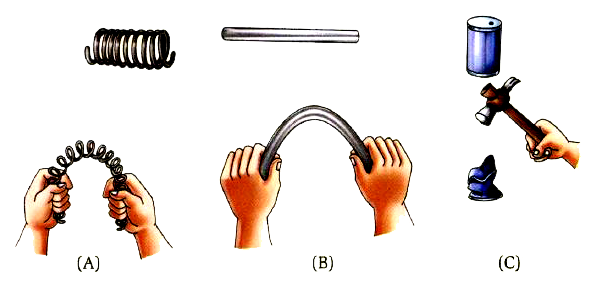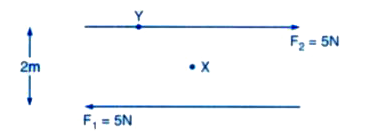State the effects of a force applied on (i) a non rigid, and (ii) a rigid body. How does the effect of the force differ in the two cases ?
Step-by-Step Solution:
1. Understanding Non-Rigid Bodies:
- A non-rigid body is one that can deform when a force is applied. This means that the shape and size of the body can change.
- When a force is applied to a non-rigid body, it can lead to changes in its dimensions (length, area, volume).
2. Effects of Force on Non-Rigid Bodies:
- When a force is applied to a non-rigid body, it changes the interspacing between the constituent particles of the body.
- This change in interspacing can lead to deformation, such as stretching, compressing, or bending.
- Additionally, the applied force can also change the state of motion of the non-rigid body, meaning it can accelerate or change direction.
3. Understanding Rigid Bodies:
- A rigid body is one that does not deform under the application of force. Its shape and size remain constant regardless of the force applied.
- When a force is applied to a rigid body, it does not change the interspacing between its constituent particles.
4. Effects of Force on Rigid Bodies:
- The primary effect of applying a force to a rigid body is that it changes the state of motion of the body (i.e., it can cause the body to start moving, stop, or change direction).
- Since the dimensions of a rigid body do not change, the interspacing between its particles remains constant.
5. Comparison of Effects:
- In summary, the effect of a force on a non-rigid body results in both a change in dimensions and a change in motion.
- Conversely, the effect of a force on a rigid body results only in a change in motion, with no change in dimensions.
Summary:
- Non-Rigid Body: Force causes deformation (change in dimensions) and can change the state of motion.
- Rigid Body: Force changes the state of motion without changing dimensions.
- A non-rigid body is one that can deform when a force is applied. This means that the shape and size of the body can change.
- When a force is applied to a non-rigid body, it can lead to changes in its dimensions (length, area, volume).
- When a force is applied to a non-rigid body, it changes the interspacing between the constituent particles of the body.
- This change in interspacing can lead to deformation, such as stretching, compressing, or bending.
- Additionally, the applied force can also change the state of motion of the non-rigid body, meaning it can accelerate or change direction.
- A rigid body is one that does not deform under the application of force. Its shape and size remain constant regardless of the force applied.
- When a force is applied to a rigid body, it does not change the interspacing between its constituent particles.
- The primary effect of applying a force to a rigid body is that it changes the state of motion of the body (i.e., it can cause the body to start moving, stop, or change direction).
- Since the dimensions of a rigid body do not change, the interspacing between its particles remains constant.
- In summary, the effect of a force on a non-rigid body results in both a change in dimensions and a change in motion.
- Conversely, the effect of a force on a rigid body results only in a change in motion, with no change in dimensions.
- Non-Rigid Body: Force causes deformation (change in dimensions) and can change the state of motion.
- Rigid Body: Force changes the state of motion without changing dimensions.
Topper's Solved these Questions
- LAWS OF MOTIONBOOK - ICSECHAPTER - LAWS OF MOTIONEXERCISE - EXERCISE - 3(A) (Multiple Choice Type)
2 Videos
- LAWS OF MOTIONBOOK - ICSECHAPTER - LAWS OF MOTIONEXERCISE - EXERCISE - 3(B)
26 Videos
- LAWS OF MOTIONBOOK - ICSECHAPTER - LAWS OF MOTIONEXERCISE - EXAMPLES
24 Videos
- ICSE ANNUAL EXAMINATION -2020BOOK - ICSECHAPTER - ICSE ANNUAL EXAMINATION -2020EXERCISE - SECTION-II
45 Videos
- LIGHTBOOK - ICSECHAPTER - LIGHTEXERCISE - TOPIC 2 Spherical Mirrors (4 Marks Questions )
9 Videos
Similar Questions
A force is applied on (i) a non-rigid body and (ii) a rigid body. How does the effect of the force differ in the above two cases ?
View SolutionGive any two effects of a force on a non-rigid body.
View SolutionWhat is the effect of force on a rigid body ?
View SolutionWhat is the effect of force on non-rigid body?
View SolutionList the different effects of force.
View SolutionState turning effect of force with example from daily life.
View SolutionIn the following pictures , figure out what are the effects of the forces on different objects.

View SolutionIf the linear momentum of a body is increased by 50%, then the kinetic energy of that increases by :
View SolutionA body is acted upon by two forces each of magnitude F, but in opposite directions. State the effect of the forces if
(a) both forces act at the same point of the body.
(b) the two forces act at two different points of the body at a separation?
View SolutionThe following diagram (Fig. 1.20) shows two parallel and opposite forces F1andF2 each of magnitude 5N, with their lines of action separated by a distance of 2m. A point X is pivoted midway between F1andF2 while a point Y is pivoted on F2
(a) calculate the total moment of the two forces about the points (i) X, and (ii) Y
(b) State the effect produced by the two forces about the points (i) X and (ii) Y

View Solution
